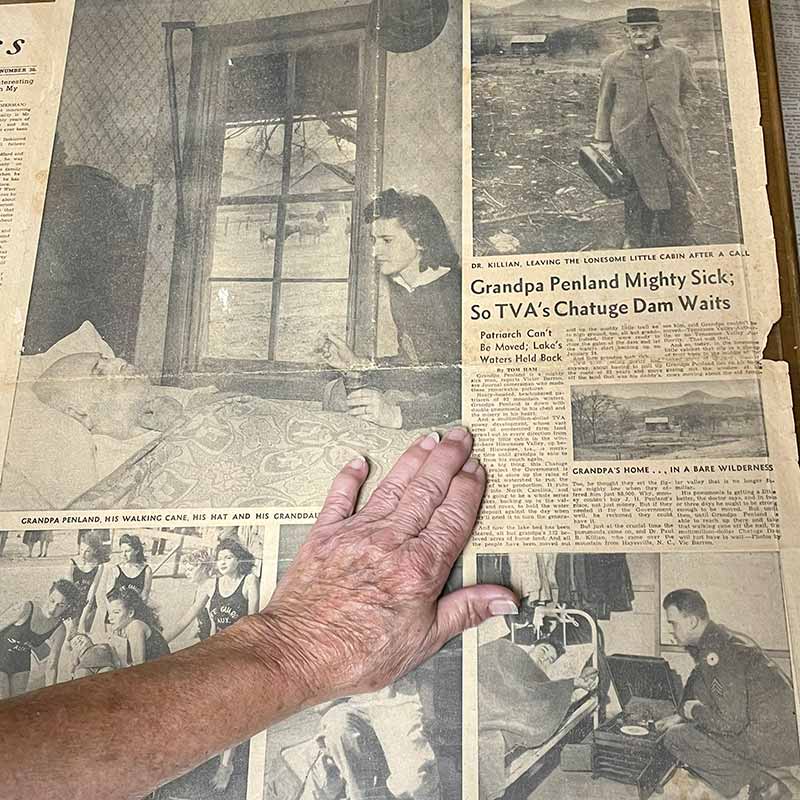Residents See Hope in Shorter Drawdown Plan
Among the seasonal shops and businesses around the edges of Lake Chatuge, the most seasonal of all may be the Hiawassee Fruit and Vegetable farmstand. During a recent summer weekend, longtime worker Janet Reynolds watched cars full of tourists stream past. She felt unsure about the future.
She’d heard TVA needed to repair the Chatuge spillway, she said, for the safety of residents downstream. And she knew a multiyear drawdown of the lake’s water would hit local shops hard, especially during the high season for tourism.
She winced. “I’ve been following it,” she said.
But there’s a development she hadn’t heard: After close study of the needed repair work, TVA reduced its drawdown expectation to just two years, limited to the off seasons.
“Oh!” Reynolds let her knees buckle in playful relief. She scooped up her chihuahua, Bella. “We were worried about that!”

Janet Reynolds and Bella.
Lake Chatuge straddles the state line, in Clay County, North Carolina, and Towns County, Georgia. TVA engineers discovered that joints in the lake’s concrete spillway had aged, and that if a large enough volume of water flowed into the spillway, it could erode the ground beneath it, threatening the spillway and the dam itself.
There’s no emergency but it’s clear, after the threat posed to the region by Hurricane Helene, the conditions create an unacceptable risk, according to lead engineer Chris Saucier.
So TVA considered several options for how to address it. Solutions ranged from rehabilitating the spillway in place to building a new one. And the work, it appeared, could take as long as eight years.
Saucier called that a “worst-case scenario” at the time and said in public meetings that TVA would work to shorten the duration if possible.
Reaction from residents was, understandably, mixed. Yes, people in the area had recently seen the destructive power of overwhelming rainfall. But communities around the lake depend on it, and braced for the economic impact of an eight-year drawdown.
So Saucier was glad, recently, to tell residents that TVA had kept its word to strive for shorter drawdowns.
“We tried to be as open and transparent as early and often as possible,” he said. “That means you don’t have all the details, at first, but as they come in, you adjust.”
Lake levels during recreational months will depend on rainfall, Saucier said. When TVA’s crews wrap up work in the spring and close the spillway to let the water rise, it’ll be up to nature how quickly that happens.
On the north side of the lake, in downtown Hayesville, there’s a little yellow building with a sign out front that reads, “Historic Hayesville.” Inside, recently, among the quilts and old clocks and cookbooks, local historian Sandy Zimmerman sat folding pamphlets extolling the area’s past. And a big part of that past, she said, is TVA.
During the Second World War TVA built a series of dams along the Hiwassee River to help provide wartime materials like aluminum. Workers finished building Chatuge Dam in 1942.
“People don’t remember now,” she said. She crossed the tiny museum to lean over a glass counter that held an old newspaper story about “Grandpa Penland,” a 92-year-old local man who lived on the land that would be flooded to form Lake Chatuge. But he fell ill with pneumonia and was confined to his bed. TVA delayed filling the lake until the next month, so he could spend his last days at home.
“When people complain about TVA, I ask them,” Zimmerman said, “What corporation do you know that would do that?”

Sandy Zimmerman points out the story of Grandpa Penland and TVA.
In the decades since, communities have grown up around the resulting lake and entwined further with TVA. For instance, on July Fourth, this year, the Lake Chatuge Chamber posted a notice: “Spend America’s birthday in Hiawassee and watch the annual Fourth of July Boat Parade on Lake Chatuge. Enjoy the rest of the day on this beautiful TVA lake.”
That closeness matters, according to Saucier, the TVA engineer.
“We really do serve all the Valley area,” he said. “That means protecting the downstream public and economic health. Both are part of our mission.”
